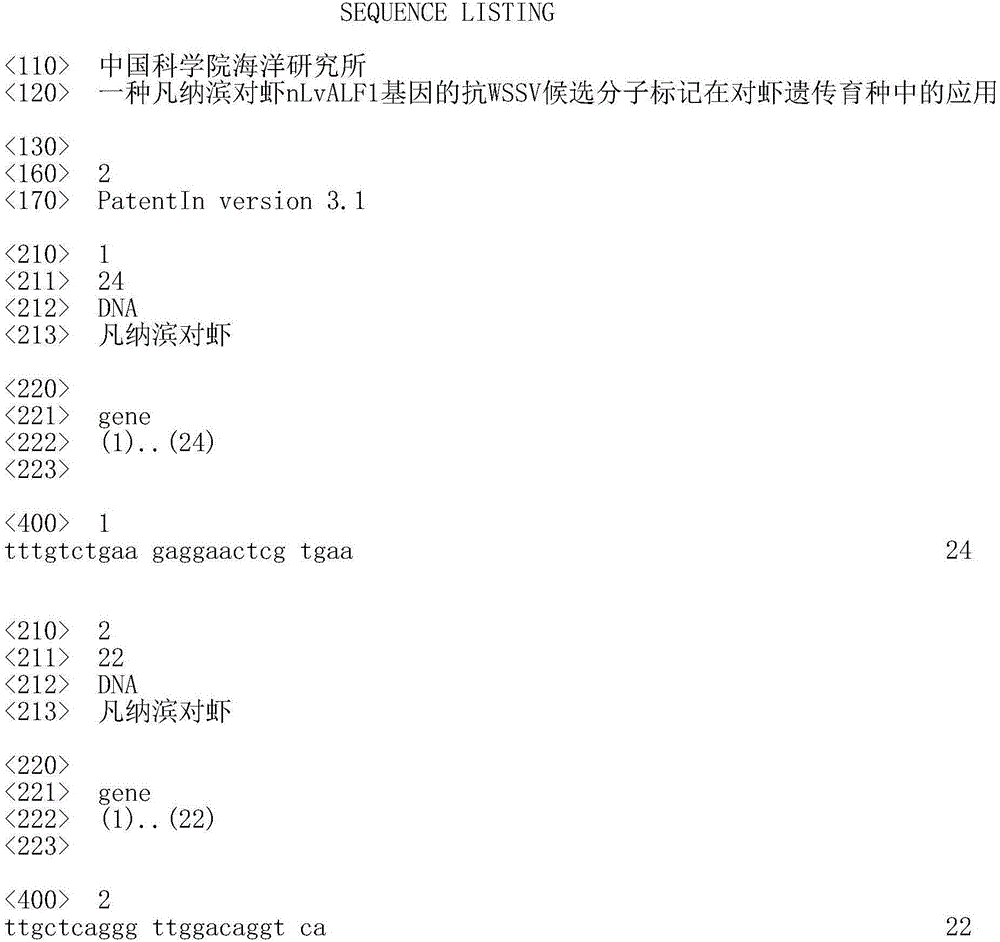Application of anti-WSSV candidate molecular marker of nLvALF1 gene of Litopenaeus vannamei to genetic breeding of Litopenaeus vannamei
A molecular marker and molecular marker-assisted technology, applied in the field of aquatic animal genetics and breeding, can solve problems such as slow progress, and achieve the effects of strong pertinence, short cycle and simple operation
- Summary
- Abstract
- Description
- Claims
- Application Information
AI Technical Summary
Problems solved by technology
Method used
Image
Examples
Embodiment 1
[0017] Example 1: Obtaining of nLvALF1g-114-T>C marker
[0018] Feed the diseased shrimps infected with WSSV to death for challenge. After the challenge is successful, collect the first dead shrimp as a sensitive group, and collect the last dead shrimp as a resistant group. Use genomic data to obtain the full-length sequence of the nLvALF1 gene, and Design primers to amplify the genomic DNA sequence, obtain the SNP sites in the sequence, obtain the SNP sites in the nLvALF1 gene, and use sequencing technology to genotype these SNP sites in the resistant population and sensitive population, and compare the SNP The difference between the genotype and gene frequency distribution of the markers in the resistant group and the sensitive group was selected, and the loci with significant differences between the two groups were screened out (see references Jingwen Liu, Yang Yu, Fuhua Li*, Xiaojun Zhang, Jianhai Xiang, 2014.A new anti-lipopolysaccharide factor (ALF) gene with its SNP pol...
Embodiment 2
[0021] Application in disease resistance breeding
[0022] 1. Extraction of DNA from breeding materials
[0023] In the breeding population, one swimming leg of the candidate broodstock was clipped, and the genomic DNA of each broodstock was extracted and labeled using the Tiangen Plant Genomic DNA Extraction Kit (Tiangen, China). Use NanoDrop 1000 to detect the DNA concentration and purity of the extracted DNA, and the detected DNA concentration>50ng / μl and purity OD 260 / 280 The individual DNA of 1.7-1.9 is detected by 1% agarose gel electrophoresis, and the individual whose DNA fragment is complete as a result of electrophoresis is selected for use.
[0024] 2. Amplification of marker sequences
[0025] Individuals obtained in the above manner will be amplified using nLvA1F and nLvA1R primers. Specifically:
[0026] The amplification system is as follows:
[0027]
[0028] The PCR reaction program was: pre-denaturation at 94°C for 5 minutes, followed by 35 cycles of a...
PUM
 Login to View More
Login to View More Abstract
Description
Claims
Application Information
 Login to View More
Login to View More - R&D
- Intellectual Property
- Life Sciences
- Materials
- Tech Scout
- Unparalleled Data Quality
- Higher Quality Content
- 60% Fewer Hallucinations
Browse by: Latest US Patents, China's latest patents, Technical Efficacy Thesaurus, Application Domain, Technology Topic, Popular Technical Reports.
© 2025 PatSnap. All rights reserved.Legal|Privacy policy|Modern Slavery Act Transparency Statement|Sitemap|About US| Contact US: help@patsnap.com


